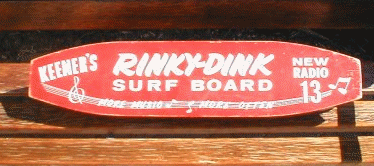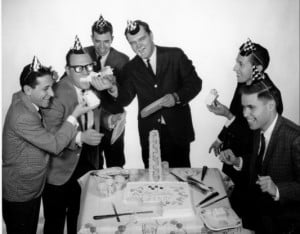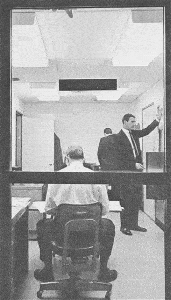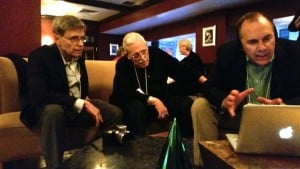
In the summer of 2002, Steve Schram came to visit me in Jacksonville, Florida. As is always the case when the two of us are in the same place at the same time, the conversation eventually turned to our favorite subject: WKNR. Before we became roommates at Michigan State University in the ’70s, we had a parallel love affair with Keener. We had collected enough jingles, air-checks and Keener memorabilia to fill a small storage shed. Steve had actually worked at a rejuvenated Keener 13 after graduation and had just written his own page in the history of the broadcast property located at 15001 Michigan Avenue in Dearborn. He was the General Manager who built Keener’s successor, WNIC, into the most successful radio property in Detroit.
But radio being radio, we were both on to other things and at last able to spend some quality time reminiscing about that 5,000 watt station with towers south of I-94 near Metro Airport. It was an unlikely success story. The signal was so convoluted that there were parts of the metro area where WKNR couldn’t be heard after dark. The competition was fierce with well funded operations chasing the same audience in a marketplace that was hungry for the alchemy of California pop, the output of the Brill Building machine, an emerging Philly sound, the British Invasion, and oh yes, that tiny operation on Detroit’s Grand Boulevard that was fast defining a genre that would become known as “The Motown Sound”.

All the elements seemed to come together for Keener. It was one of few stations in the country that was guided by a woman. Nellie Knorr found herself thrust into the CEO chair of a partnership between her family, the McCoys and Hanson’s, who owned an also ran radio station, then known as WKMH. It was her husband, Fred, who was the broadcaster, partnering with John Fetzer in the Detroit Tiger baseball club, and building a network of radio stations across the state that included farm teams in Jackson, Flint and Battle Creek. But after Fred Knorr’s untimely death, it was Nellie who had the courage to bring in programmer Mike Joseph to try out this new idea, a juke box with personality, that Todd Storz and Gordon MacClendon were turning into solid gold in places like Dallas and Miami.

She also had the good sense to give program director, Frank Maruca, the latitude to empower the air staff to modify Mike’s rules, cutting out all but the essentials, creating an environment of what Keener legend, Bob Green, would call, “intelligent flexibility”. In essence, the DJ’s had the freedom to experiment, to take the pulse of the listeners and instantly adjust to create a strong personal bond with Detroit. Yes, there was a 31 tune playlist, but that didn’t preclude experimentation. And interaction with the audience was paramount. The listener became part of the show, over the phone and often in person. It didn’t matter if the prize you won was a Keener ball point pen or a Pontiac GTO, such was the energy of this singular entertainment engine that you wanted to connect with the “Key Men of Music” who so ably and authentically connected with you.
Bob Green convinced you to stay in school. Scott Regen introduced you to Stevie Wonder, the Four Tops and the Supremes. Michael J. Wilson turned the Mickey Mouse character into a wise-cracking Rodney the Rodent. And Gary Stevens’ Wollyburger could regularly be heard gobbling up things in the control room, culminating each feeding frenzie with a huge belch.

In the middle of this organized chaos sat one of Detroit’s most competitive and respected news operations. Headed by Philip Nye, WKNR Contact News was a launching pad for Detroit TV legend Bill Bonds, for Erik Smith, John Maher, Ed Mullin, Jim Brooker, and WJR’s Frank Beckmann. Keener won dozens of awards and even turned the station into an all talk operation on November 22nd, 1963 when President Kennedy’s assassination focused us more on conversation than on music.
Keener sponsored all the important concerts, earned exclusive interviews with the Beatles, emerging Motown acts, the Monkees, the Animals, Herman’s Hermits and television stars like Lilly Tomlin. If it was happening in popular culture, you heard it on Keener. That was also reflected on the FM side of the dial, where WKNR-FM was an early experimenter with what became known as “Progressive Rock”. The way that Jerry Goodwin tells the tale, he convinced the program director to let him bring his own records into the studio, play longer cuts, interspersed with knowledgeable commentary. Russ Gibb‘s audience interaction amplified the “Paul McCartney Death Legend” to international prominence. And new acts like Iggy Pop, Savage Grace and the MC5 found a new outlet for their electrified take on rock and roll.
In time, the station was a victim of it’s own success. Increasing commercial loads and cost cutting (sound familiar?) opened the door for a more powerful signal across the Detroit river in Windsor, Ontario to step in. CKLW became the dominant rock station in the market and in April of 1972, John McCrae uttered the WKNR call letters for the last time over the strains of the Byrd’s “Turn, Turn, Turn”.
“To everything, there is a season.” And from Halloween Night, 1963 through the spring of 1972, every season was Keener season. A generation of radio listeners trace the sound track of our lives to 1310 on the AM dial. It was a story worth preserving. And one summers evening in 2002, Steve and I decided to take the project on.

Each of us had relationships with many of the players in the story. And they were all generous in contributing material. Bob Green was our mentor, not only sharing hours of recordings, music guides and pictures, but giving us perspective on how and why Keener became so successful. Keener fans like Frank Hartge, Jim Feliciano, The “Reel” Tom Ryan and John Freist, were essential to filling in the blanks. And to this day, we still receive memories and material from enthusiasts who are discovering Keener, not only here but via our Facebook and Twitter outposts.
Today in Keenerland last 13 years include two moments in time when Keener came back to life. Thanks to programmer Dom Theodore, we were given the original WKNR property, 1310 Khz, for two Woodward Dream Cruise Weekends. Surviving Keener Key Men Scott Regen, Michael Stevens, Pat St. John and Bob Green contributed their talents and we dug up classic air checks from Dick Purtan, Frank “Swingin” Sweeney, Robin Seymour, the late Mort Crowley and others to recreate the WKNR sound, one more time.

There were the Detroit Radio Reunions, spearheaded by “Radio’s Best Friend”, Art Vuolo, where Detroit DJs from every station came home to reminisce. Keener always seemed to be at the center of the conversation. And there was a magical gathering of the original WKNR Key Men in New York City, an event that Steve and I were honored to attend, where the rarefied group of announcers who made Keener what it was, came together one more time to ponder how fate, talent and timing intersected to make it possible for them to make broadcast history.
WKNR went “from worst to first” in 62 days back in late 1963. In the context of history, her prime was exceedingly brief. But her influence continues to this day, not just here, but on sister sites like Motor City Radio Flashbacks, and wherever people gather to remember what it was like back in the day when garage bands could become rock stars, when Detroit was the automotive capital of the world and a small group of men and women gathered in Dearborn to help change the definition of popular music.. forever.
Keener13.com has been a labor of love for Steve and me these past 13 years. Our ability to tend to the site has ebbed and flowed as we’ve raised our own families and built our own careers. But we’ve always returned here, to add some fresh content, to respond to the welcome questions and comments that continue to come our way, and to tell the Keener tale to a generation that consumes music on smart phones and never knew the thrill of interacting with that friend who’s voice helped you navigate your youth through the small speaker of a transistor radio.
Keener lives!

